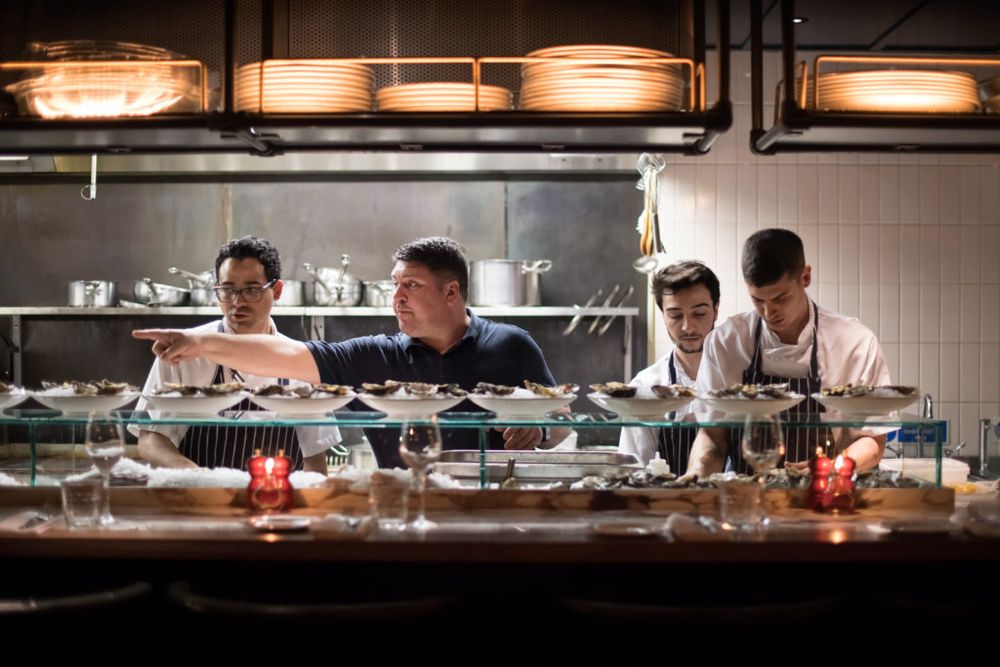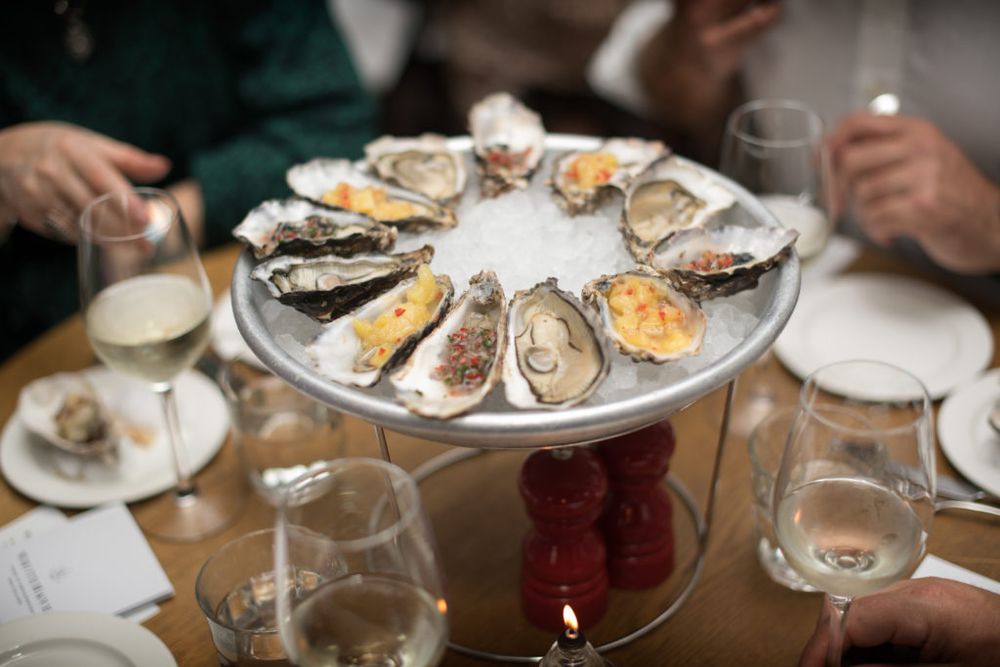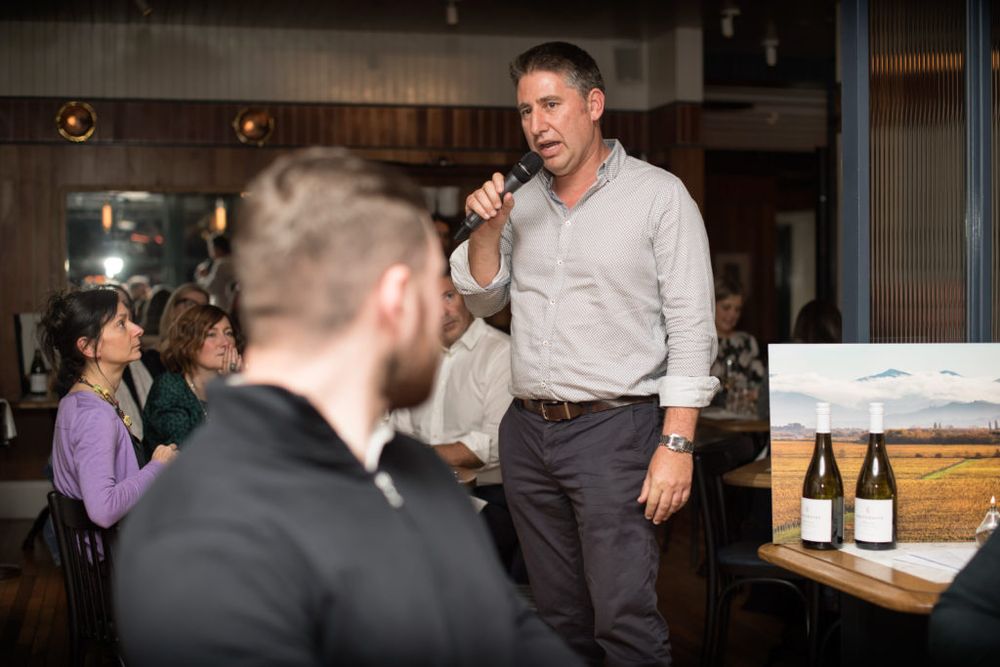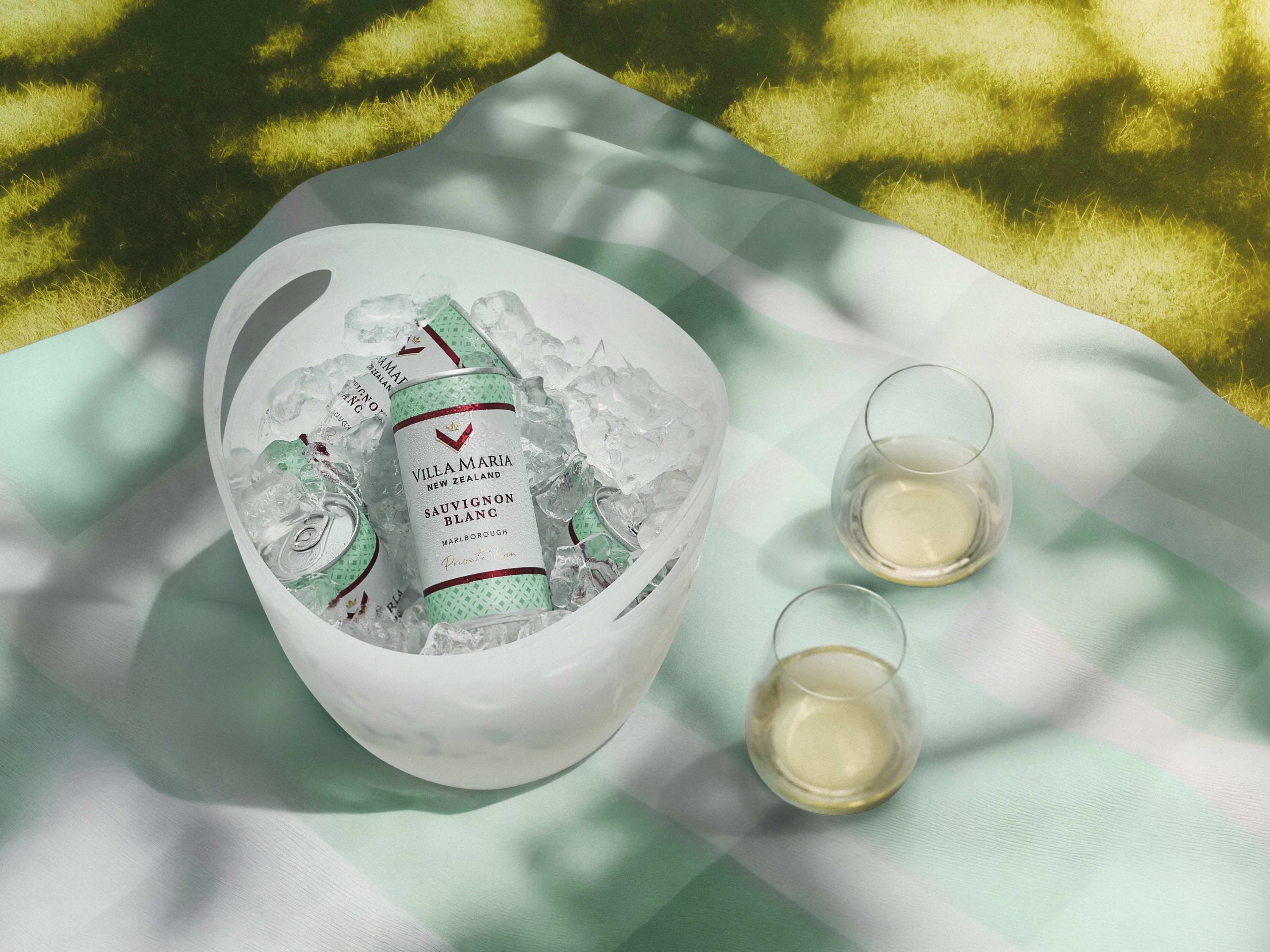We also put Whitehaven Sauvignon Blanc to the taste-test pairing it with a variety of seafood and dessert at Wright Bros in Battersea.

Sam Smail and Peter Dean, Wright Bros, Battersea, February, 2019
In the world of pop music cracking the American market was always the holy grail of all bands. If you could make it there you could make it anywhere. For Whitehaven owners Greg and Sue White when they started the winery in Marlborough, New Zealand in 1994 little did they realise that Whitehaven would become one of Marlborough’s largest family-owned wineries and one of America’s most popular brands of Sauvignon Blanc.
When chief winemaker Sam Smail joined Whitehaven in 2000, it was still pretty much a Mom and Pop wine estate located at the top of New Zealand’s South Island. The winery was producing just 15,000 cases of wine every year, with most sold through the on-site restaurant. Greg and Sue didn’t own any land nor the winery so when they moved to a larger site in 2002, they bought land and, in a remarkably short space of time, enlarged four times, acquiring more and more vineyards until Whitehaven now owns a whopping 150 hectares – and even that only gives them a third of the grapes they need to keep up with demand, with the rest coming from 40 growers.
“When I started with the company we had about eight growers, quite small as well, in fact it was all quite a small operation then,” Smail recalls, sipping a cocktail in the bar of Wright’s, just before a customer wine dinner begins. “We moved in 2002 because there wasn’t enough room and then where we moved to, we’ve had to expand about four or five times as well.”
A Kiwi by birth, Smail had worked in wineries in Napa and Italy following his degree in Chemistry at the University of Adelaide, it was then that he joined Whitehaven under the direction of Simon Waghorn (who has since gone on to form Astrolab), with 2009 his first vintage in charge.
“In 2000 the company owned no land, it didn’t even own the winery, there was another wine company that was moving on so they did a leasing deal on the tanks and the hoses and it all started from there.”
The phenomenal growth has been facilitated in part by the relationship with E&J Gallo who has been Whitehaven’s distribution partner since 2003 and helped grow the US market from 5,000 cases to 350,000 cases. Whitehaven is now the number one Sauvignon Blanc by the glass in the US.
“The on-trade is hugely important for us,” Smail continues, “it is a big focus because it’s where we want to be – at the premium end of the market – and historically it has introduced a lot of people to the brand.”

Richard Kirkwood, Wright Bros, Battersea overseeing the Oysters: 4 ways
Showing the versatility of Sauvignon Blanc – with every course
Another reason for the on-trade success of Whitehaven’s Marlborough Sauvignon Blanc is its versatility on a menu, and to prove it, this interview and tasting is being held in Wright Bros restaurant at Battersea Power Station, with chef Richard Kirkwood cooking a diverse four course menu to show off the wine to good effect.
Unusually for this type of winemaker’s dinner we stick to just one wine throughout the meal to prove the point that Marlborough Sauvignon Blanc is not just good by-the-glass but also by-the-bottle and will work well with a wide range of strong flavours. Smail explains:
“One of the reasons for the success of Sauvignon is that it’s a very good food match. It goes very well with the style of food today– vibrant flavours. It’s also versatile: Seafood, anything with an acid component, tomato or a vinaigrette, salads, it can stand up to a little spice in the food. The flavours in the wine are pretty intense so it pairs with intensely flavoured foods as well.”
And the food we taste-test the wine with is intensely flavoured, it’s almost an assault course of some of the most difficult foods to match wines to. And yes, that includes artichokes.

The meal commences with four oysters, each served differently, the most popular around the tables of paying customers being with the grapefruit vinaigrette. Next comes Josper roasted mackerel with blood orange, fennel and chicory salad that is a great match. The main course is pan-fried fillet of gurnard, roasted Jerusalem artichokes, kale and pickled cockles. And even with the rhubarb and blood orange vanilla cream dessert, the Sauvignon passes the test with flying colours.
This being a New Zealand Sauvignon Blanc, the wine has a screwcap – a sommelier’s by-the-glass friend but also, Smail believes, a great way for the wine to age.
“Sauvignon Blanc does age well, it can be drunk very soon but we make it so that it can age – we use a little bit of lees contact – and the vine age helps as well, so our oldest vines are getting on for 30 years old now.”

The need for consistency
Whitehaven is classed as super-premium by some systems, in retail it is priced much higher than the average brands. In terms of the working relationship with E&J Gallo, though, Smail explains that it is primarily a distribution deal, although they do come along to the grading tasting. With these sorts of volumes consistency of quality and style is everything
“We have a little bit of vintage variation but we try and minimise it – but one of the beauties of Marlborough is that it is very consistent, the growing season and so on. For a larger blend you want that consistency and making what the customer wants – the wine has got that intensity of flavour but now we need to be looking at the structure and the longevity of the wine as well.”
Smail explains he has to balance this consistency with looking at changing needs – how the market is moving and also his team’s own curiosity.
“I think we always like to explore new areas and from a vineyard point of view that means looking at new clones of Sauvignon Blancs – as winemakers we’re never happy, we always want to make a better wine. We always want to try new things, so in terms of Sauvignon Blanc, a lot of it is matching certain yeasts to certain vineyards, trialling different things – like trying to get a bit more intensity from the thiols, adding some solids in the ferment, different temperatures, some ageing on the lees – a lot of it is to get a focus on that grading tasting and getting certain flavour descriptors that we’re after.”
“So we’re after are what we describe as the ‘riper greens’, so they add a lot of freshness… by default Marlborough Sauvignon Blanc has a lot of that citrus, that grapefruit flavour so when we are doing our grading we’re looking for other flavours outside of that: gooseberries, nettles, greengage plum, jalapeno, tobacco leaf, maybe a little bit of red capsicum and sometimes that nice flintiness as well. The pungency we’re looking for are more boxwood and blackcurrant leaf.”
One of the advantages of being a big player is that Smail can use grapes grown from all of the main areas in Marlborough – which each have their own distinct flavour profile – so that he can make a blend as if he was an artist with his own palette.
“We’ve got growers and bought vineyards in the areas that we like, so typically for our style the biggest sub-regions are the Awatere Valley and Dillons Point (that make up about 50%). We find that we get a lot of intensity of flavour from Dillons Point and Awatere, the other regions add palate weight and structure to the wine.”

Deviating into alternate styles of Sauvignon
Sadly Greg White passed away in 2007 and is remembered with two single vineyard cuvées, with fruit sourced from Awatere.
“We do a Sauvignon and a Pinot Noir under that range, they are both from Awatere Valley so they have distinct Awatere characteristics – more of the minerailty, the crushed rock notes.”
Smail also does a limited ‘alternate’ style of Sauvignon Blanc called The Hidden Barrel.
“As winemakers we decided to do a little experiment, we made two barrels of this wine and we didn’t tell the owners about it. It’s made completely differently, we get the fruit a little riper, we hand pick it, then we foot stomp it and then it goes under spontaneous fermentation, with fine solids in larger format 500 litre barrels, 4-5 year old French oak, so it’s just got a larger volume and builds up a bit more heat; the ferment is a bit stronger a bit more vigorous which gives the wine bigger mid-palate and more texture, it’s also aged on lees for six months.”
This style of Sauvignon Blanc, like the main flagship Whitehaven Marlborough Sauvignon Blanc, does not go through malolactic fermentation although the Chardonnay does, the Pinot Noir and obviously the sparkling.

Whitehaven produces 10 wines, making roughly 20-25,000 cases of Pinot Gris, Chardonnay, Riesling, Gewürztraminer, sparkling, Rosé, Pinot Noir and a Noble Riesling. The bulk of the winery’s 400,000 cases per annum output, however, is the flagship Sauvignon Blanc with 375,000 cases.
Smail has two other winemakers to work with, with each of them being wholly responsible for the other varieties. Then there are 10 in the winemaking team, 10 in the vineyard team and others in the office and off-sales.
As with a lot of other New Zealand wineries export is a massive proportion of output – 97% of output in Whitehaven’s case – and on-trade is also key, making up 30-40% of the 350,000 cases that make it to the US. Breaking into the UK on-trade is one of the company’s main priorities as is seeing the UK rise up in the export rankings – the UK sits behind the US, Canada, Australia and Asia.
Another key objective is to make the winery zero wastage by 2025. Smail explains how Whitehaven already takes sustainability very seriously, recycling grape skins, being part of New Zealand Soil Sustainability, minimising tractor usage, insulating and using water in a sustainable way. They also do a wine label called Kopare Pare that supports sustainable fishing in New Zealand.
Challenges are the ones faced by other New Zealand winemakers – a labour shortage and the weather.
“The latest vintages, 2017 and 2018, have been quite challenging,” Smail says, “there’s been a lot of pressure to pick before big rain events and there has been quite short and sharp harvests, but that’s the advantage of having our own winery, we can crank it up and bring the fruit in really quickly. Hopefully the 2019 harvest is going to be a little bit longer so you can get some variation in ripening times and can pick at the optimum time for each area.”
For further information about stocking Whitehaven Sauvignon Blanc, contact Charles.yates@ejgallo.com
E&J Gallo is a supplier partner of The Buyer for more information about them click here.










































